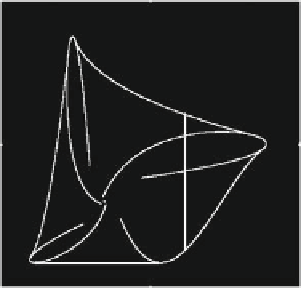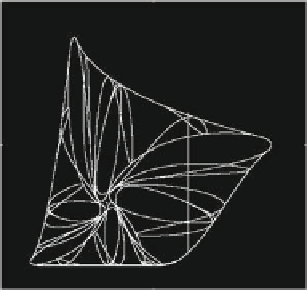Chemistry Reference
In-Depth Information
0.7
0.7
y
y
LC
2
LC
5
LC
6
LC
1
LC
4
LC
−1
LC
3
LC
-1.6
-1.6
x
x
-1.6
1
-1.6
1
(a)
(b)
Fig. C.8
Delineating more precisely the structure of the absorbing area of the quadratic map
given by (C.5). (
a
) Higher order iterates of the boundary curves. (
b
) After a sufficient number of
further iterates the inner boundaries of the chaotic area emerge. These should be compared with
the frequently visited areas of the chaotic trajectory in Fig. C.7a
that we take a smaller segment and that we take a higher number of iterates in order
to also obtain the inner boundary. The result is shown in Fig. C.8a, where after four
iterates we get the outer boundary. After a few more iterates the inner boundary of
the chaotic area is also obtained, as shown in Fig. C.8b. As can be clearly seen, and
as clearly expressed by the strict inclusion in (C.13), the union of the images also
include several arcs internal to the invariant area
. Indeed, the images of the critical
arcs which are mapped inside the area play a particular role, because these curves
represent the “foldings” of the plane under forward iterations of the map, and this
is the reason why these inner curves often denote the portions of the region which
are more frequently visited by a generic trajectory inside it (compare Fig. C.7a and
C.8b). This is due to the fact that points close to a critical arc LC
i
, i
0; are more
frequently visited, because there are several distinct parts of the invariant area which
are mapped into the same region (close to LC
i
/ in i
C
1 iterations. Many similar
examples are given in the literature on noninvertible maps, see for example Mira
et al. (1996).
Examples of applications in dynamic economic modeling are given in Bischi and
Naimzada (1999), Bischi et al. (2000a), Puu (2003), Agliari et al. (2000a), Agliari
et al. (2000b), Agliari et al. (2002b), Agliari et al. (2004), Chiarella et al. (2001),
Chiarella et al. (2002), and Sushko et al. (2003).
A
C.4
Critical Sets and the Creation of Disconnected Basins
From (C.11) it is clear that the properties of the inverses are important in order
to understand the structure of the basins and the main bifurcations that change
their qualitative properties. In the case of noninvertible maps, the multiplicity of



Search WWH ::

Custom Search